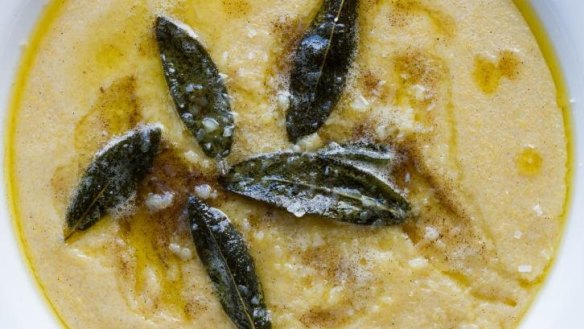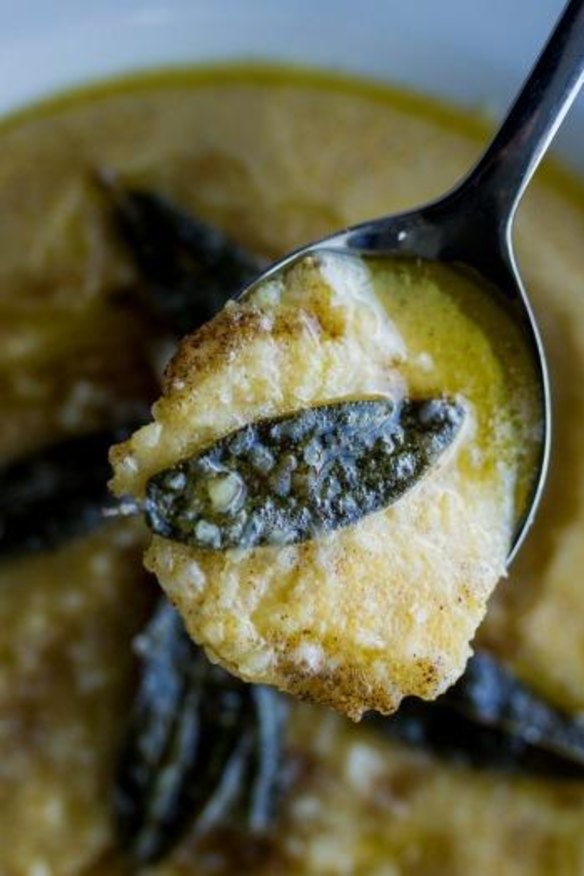Ted Kizor's easy one-pot feast for a Canberra winter

This week I'll leave you in the capable hands of my man, Ted Kizor. Out of San Francisco, he came to work this vintage and is a young guy with a lot of worldly knowledge who can cook like a pro. This dish he served for lunch is one of the best one-pot dishes you'll have, and the polenta accompaniment is just get-outa-here freakin' awesome. Ted, over to you ...
Fall. Autumn: To many it means the changing of leaves, the start of wood fires, and some well-needed bouts of refreshing rain. For me it means the end of crush. With wet, cold wind blowing around me as the last fruit comes in (some very lovely Muscat) I head up to my cottage. Since last night I've left something special to simmer on the stove – Sunday sauce with a brown butter sage polenta. Every Thursday at Clonakilla we have a family-style lunch. This gives Bryan Martin (your normal columnist, my boss) a chance to whip up his latest culinary invention. It's one of the great perks at working at such a friendly winery.
Being a bit of a foodie myself I've chosen to whip up something that is simple, easy, and will impress even the chef-iest of your friends. It just takes a little time, a trip to the butcher, and a large thick-bottomed pot. Sunday sauce is what I call a generic sugo or ragu. Generally, it's slowly cooked beef in a rich tomato based broth that hails from the south of Italy. However, you can use just about any meat from chicken to lamb. It's the perfect slow-cooked savory dish to ease away the wintry cold and is great for dinner parties and groups because it's 100 per cent cooked ahead. If you've got a good crusty loaf of bread to mop this up, it's heaven. So for me it's the perfect way to wind down an excellent vintage.

Sunday sauce
About an hour or so before starting this recipe, leave the beef and pork out of the fridge so that they come to room temperature.
2kg beef chuck
750g pork spare rib
6 uncooked Italian or chorizo sausage
1 bulb garlic, peeled, whole cloves
1 bulb garlic, peeled and sliced
4 onions, peeled and sliced lengthways
2 fennel bulbs, sliced lengthways
2 cans peeled whole tomatoes
750ml passata
2 bay leaves
¾ bottle red wine
olive oil, salt and pepper, chilli, cayenne to taste

Dry the meat with paper towels and season the beef and pork generously with salt and pepper. Add enough olive oil to coat the bottom of a thick-bottomed stockpot – use something that you can be without for a few days. On medium-high heat, brown the beef thoroughly on all sides. Reserve the browned beef.
Brown the pork spare ribs in the same manner and also reserve. Pro tip: remember that you're not trying to cook the meat through, but if you give the meat a good crust now you'll have a better fond and therefore a better sauce.
Add sliced onions and fennel bulbs to the pan with a generous pinch of salt and pepper – the salt will bring more moisture out of the onions, deglazing the fond in the pan.
Once the onions are soft and translucent, add the sliced garlic and chili to taste. Return the meat and any accumulated juices to the pan. Add the wine, whole canned tomatoes, whole garlic cloves, passata and bay leaves.
Add enough water or wine so that the meat is covered. Bring up to a simmer and then turn down the heat to its lowest setting, just allowing one or two little bubbles to come to the surface. Leave the sauce simmering like this for as long as possible, preferable overnight, but for at least six hours. This allows for all of the connective tissues to break down and gives the sauce a rich meaty texture. If the sauce looks to thick, add more water or wine. Stir occasionally.
One hour before serving add the sausages to the pot and bring the heat up to medium-low. Add any additional salt, pepper, and chili to taste. I prefer to cut the sausages in half, once cooked, for easier portioning.
This dish is typically served as two dishes, a primi and a secondi. For this you remove the meats to serve as secondi. For the primi make pasta – think tagliatelle or rigatoni, something that the sauce can cling to – and stir in with the sauce.
You see this dish and dishes similar to it all over southern Italy served at large family gatherings. It's perfect in cold weather and it is the sauce that crusty bread dreams of mopping up. Buono gusto!
Brown butter sage polenta
1 cup polenta
1L chicken stock
3 tbsp heavy cream
50g grated Parmesan
1 cup butter
10 sage leaves
salt and pepper
In a medium saucepan bring the chicken stock and a generous pinch of salt to a rolling simmer. Whisk in dry polenta and reduce heat. As the polenta thickens, add three quarters of the butter, cream and cheese. If the polenta looks a little dry, add more water, if it's looking wet continue cooking on low heat.
In a separate sauté pan, heat the remaining butter and sage with a pinch of salt and pepper. Once the butter starts to foam up, you're getting close. Be careful not to burn the butter, or you'll have to begin again.
Once it's done to your liking, pour the brown butter sage on top of the creamy polenta. Instagram, show off to your guests, then mix it in and serve. Buono Gusto!
The best recipes from Australia's leading chefs straight to your inbox.
Sign up